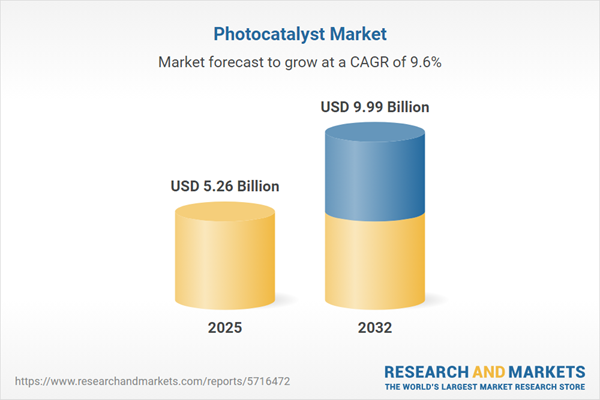Speak directly to the analyst to clarify any post sales queries you may have.
Photocatalyst solutions are transforming sustainability strategies for businesses seeking to boost environmental stewardship, improve operational efficiency, and address regulatory priorities. Senior decision-makers are leveraging these technologies to enhance compliance, strengthen competitive standing, and meet evolving market requirements.
Market Snapshot: Photocatalyst Market Growth Outlook
The global photocatalyst market continues its upward trajectory, forecast to expand from USD 4.79 billion in 2024 to USD 5.26 billion in 2025, with a projected reach of USD 9.99 billion by 2032. This represents a robust compound annual growth rate (CAGR) of 9.61%. Growth is largely propelled by intensifying environmental regulations, rapid advances in material innovation, and broader application across verticals such as construction, healthcare, and manufacturing. Senior executives closely monitor these trends, as increasing compliance obligations are prompting organizations to adopt proactive resilience measures and position themselves for long-term value.
Scope & Segmentation in the Photocatalyst Market
This market research delivers a comprehensive overview of the segments shaping strategic planning and operational initiatives in the photocatalyst market. Each segment was chosen for its relevance to current industry needs and sector-specific investment priorities:
- Product Types: Titanium dioxide (TiO₂) and zinc oxide (ZnO) help drive pollution mitigation, specialty coatings development, and advanced air and surface management solutions within multiple sectors.
- Form Factors: Coatings, powders, and films allow for flexible deployment, enabling smooth infrastructure upgrades and supporting sustainable building and environmental programs.
- End Users: The technology is adopted across residential, healthcare, chemical, energy, waste management, and public infrastructure, reflecting broad industry relevance.
- Applications: Use cases include air purification, antimicrobial coatings, self-cleaning surfaces, and advanced water treatment, supporting compliance goals and bolstering process reliability for organizations facing increasingly complex regulations.
- Technological Platforms: Ultraviolet and visible light-responsive photocatalysts provide adaptability for different site needs and sustainability standards, reducing operational challenges and aiding with global project consistency.
- Regional Insights: Variations in adoption are shaped by local regulatory demands, infrastructure conditions, and targeted environmental policy efforts in the Americas, Europe, Middle East & Africa, and Asia-Pacific. Emerging markets often emphasize innovation aligned with urban development, while established markets prioritize regulatory compliance and performance.
- Leading Companies: Competitive dynamics are led by innovative organizations such as Evonik Industries AG, Merck KGaA, Ishihara Sangyo Kaisha Ltd., Tayca Corporation, Showa Denko K.K., Tronox Holdings plc, Kronos Worldwide Inc., Venator Materials PLC, Cabot Corporation, and PPG Industries Inc.
Key Strategic Takeaways for Senior Decision-Makers
- Visible light-responsive photocatalysts play a key role in delivering safer working conditions and supporting organizational health and sustainability mandates.
- Integration of next-generation photocatalytic materials within existing assets positions enterprises as environmental leaders and enables more effective resource management, particularly in regulated sectors.
- Collaboration between manufacturers, technology partners, and industry stakeholders fosters the development of innovative solutions and supports the standardization of quality throughout the value chain.
- Strategic partnerships, such as joint ventures and supply chain collaborations, help accelerate adoption, drive technology transfer, and support timely responses to shifting operational environments.
- Adoption strategies for photocatalyst technologies are increasingly aligned with long-term risk management and sustainability goals prioritized by executive leadership in automotive, construction, and utilities.
- Customizing technology investments in response to local regulation and evolving policy ensures greater organizational adaptability and resilience to future compliance demands.
Tariff Impact: Supply Chain and Trade Dynamics
Forthcoming adjustments to U.S. tariff policy for 2025 have prompted organizations in the photocatalyst industry to strengthen supply chain strategies. Common responses include investing in local manufacturing capacity, expanding supplier portfolios, and implementing advanced inventory planning processes. These actions are designed to mitigate uncertainty in international trade and protect project schedules during periods of market volatility.
Market Research Methodology & Data Sources
This report utilizes a robust methodology, incorporating interviews with senior executives, guidance from scientific advisors, and detailed analysis of academic journals and patents. The resulting insights are curated for practical use by executive leadership, ensuring all findings rest on well-validated research and regulatory assessments.
Why This Photocatalyst Market Report Matters for Leadership
- Access timely intelligence that enables strategic alignment of technology adoption with compliance requirements and long-term sustainability objectives.
- Gain practical data and insights for improved procurement, investment, and operational planning across diverse business functions.
- Empower management teams with actionable strategies for implementing photocatalyst-based solutions that deliver enhanced compliance and measurable operational improvements.
Conclusion
This report guides senior executives through a fast-evolving sector, offering focused analysis and supporting informed decision-making for sustainable growth and effective risk management in the photocatalyst market.
Additional Product Information:
- Purchase of this report includes 1 year online access with quarterly updates.
- This report can be updated on request. Please contact our Customer Experience team using the Ask a Question widget on our website.
Table of Contents
3. Executive Summary
4. Market Overview
7. Cumulative Impact of Artificial Intelligence 2025
Companies Mentioned
The companies profiled in this Photocatalyst market report include:- Evonik Industries AG
- Merck KGaA
- Ishihara Sangyo Kaisha, Ltd.
- Tayca Corporation
- Showa Denko K.K.
- Tronox Holdings PLC
- Kronos Worldwide, Inc.
- Venator Materials PLC
- Cabot Corporation
- PPG Industries, Inc.
Table Information
| Report Attribute | Details |
|---|---|
| No. of Pages | 189 |
| Published | November 2025 |
| Forecast Period | 2025 - 2032 |
| Estimated Market Value ( USD | $ 5.26 Billion |
| Forecasted Market Value ( USD | $ 9.99 Billion |
| Compound Annual Growth Rate | 9.6% |
| Regions Covered | Global |
| No. of Companies Mentioned | 11 |









